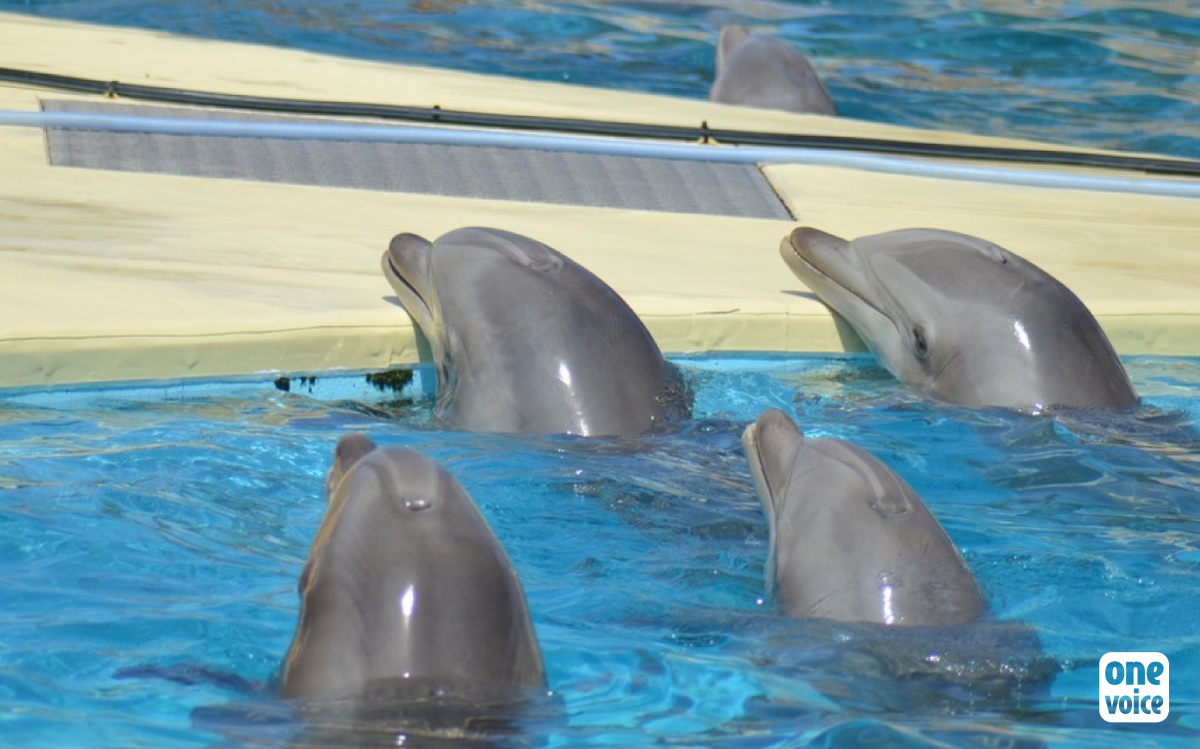

Alize
On the 13th of May 2016, the young Alize died at the age of 24 in a medical pool at Marineland, Antibes. According to the park, the dolphin had been suffering from incurable kidney problems for some time. Ok, but what were these problems? And why were they incurable?
As is typical upon hearing a eulogy from a dolphinarium, we are left feeling perplexed. “The trainers were fond of her independent personality, she was cheerful and playful. Alize was part of a group of dolphins whose births, over the last decades, ensure the continuity of future generations”. Independent and playful? Alize was a slave, son of slaves, and had no choice other than to ‘play’ rather than hunt and explore the vast ocean with his friends. As for the continuity of generations, he will never be a father. And in his last year, he was no longer cheerful… At the beginning of 2015, an internal source leaked that two dolphins had died. A third, Alize, was very ill. In July, the director finally declared, “Eclair died in February 2015, Mila-Tami in January 2015. Alize is still with us, I just said goodbye to him before leaving”. Recently however, a white tent covering the medical pool was generating curiosity – a sign that a dolphin was dying. It was Alize, broken by an “incurable kidney disease”.
What disease are we talking about?
Without access to the medical files, we can only guess, but all evidence points to kidney stones, as is the case for many other captive dolphins.
”
Comparison of Nephrolithiasis Prevalence in Two Bottlenose Dolphin Populations,” a scientific study published in 2013 explains essentially that, “Nephrolithiasis, or urinary tract stone disease is very common in the Tursiops species kept in dolphinariums.” “In contrast, comparative analysis shows that this disease is not present in the natural environment of the wild dolphins in Sarasota Bay”.
In other words, Alize’s kidney problems were a direct consequence of life in captivity.
Many other infections of this type, which can be classed as nosocomial infections, decimate the pools. But also lung diseases provoked by chlorine, kidney diseases linked to massive consumption of food supplements and an excess of red blood cells, stomach ulcers induced by stress, and fungal infections due to a life confined in warm and badly filtered water, etc. As for the kidney stones, the insufficient hydration of dolphins fed on frozen fish could be the reason – as well as them being fed solely during the day as their keepers don’t work at night. All of the risk factors are of course amplified by the breakdown of their immune defences under the weight of their despair and boredom.
Alize undoubtedly suffered. Urinary tract stone disease can be exceptionally painful, alongside the violent renal colic that it provokes.
It is strange however, that this is the cause of death, just when his kidney problem was being correctly treated. What could have happened? As is often the case in other dolphinariums, Alize’s condition must have suddenly got worse due to a bacterial infection. The SeaWorld captive orca, Tilikum, is suffering from this. Having been fed antibiotics all of his life, an antibiotic resistant bacteria is wreaking havoc, generating concerns for his health.
Last year, Eclair died at the age of 26 from prostate cancer.
Mila, his daughter, died at the age of 9 from a gastric obstruction after eating plant matter. Previously, the orca Valentin died from a twisted intestine and his mother from a heart attack! These types of endings are not very common in the ocean, where causes of death are more likely to be old age, getting caught in a net, being mutilated by a boat, falling victim to an epidemic or major pollution rather than dying by swallowing seaweed soaked in chlorine! But these risks haven’t really stopped the species Tursiops truncates from doing pretty well and from abundantly populating the warm seas of the world. In contrast, it is troubling to note that three young captive dolphins have just died in the last three months, when they were all born in a pool surrounded by carers and vets, protected from any danger, pollution or lack of food. Despite this, no Marineland dolphin has ever reached old age (60 years) or even the average age (40 years) of wild dolphins, as established by the NOAA (National Oceanic and Atmospheric Administration).
Why?
Because large migratory marine species, bestowed with a keen intellect and a rich social life, can never blossom in these aquatic cells. Captivity is fundamentally toxic for cetaceans and this is why One Voice demands their immediate abolition on all of the French territory.
Please help us and sign our petition!
Sources
- http://europepmc.org/articles/PMC3797464
- http://www.merckvetmanual.com/mvm/exotic_and_labor…
- http://www.ncbi.nlm.nih.gov/pubmed/16475528